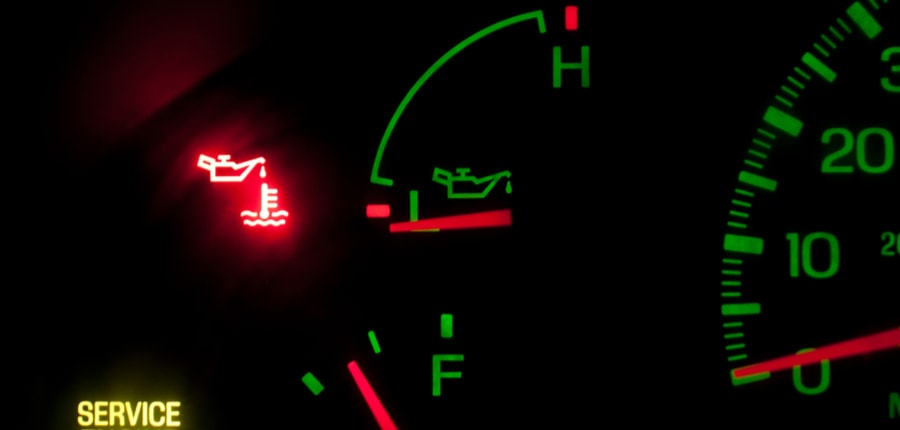The oil pressure sensor tells the PCM how much oil pressure the engine has. There are two main types of sensors. The first measures the pressure on a graduated scale – whether it operates a gauge or simply informs the PCM.
This is usually used on vehicles that run a higher oil pressure to operate a variable valve timing system. In order to modulate valve timing for best fuel efficiency, oil pressure metered through a valve is used. The PCM needs to know what the oil pressure is to do that effectively and the result is optimal fuel mileage and performance.
The second type of oil pressure sensor is sometimes called an oil pressure switch as it uses an internal diaphragm and spring assembly to open or close a set of contacts – either the pressure is good or it’s not. If the oil pressure is too low to operate the contacts, an oil pressure warning light appears on the dash.
Costs of Oil Pressure Sensor Replacement
Whichever type is used, the location and the replacement procedure is about the same. The usual location is close to the oil filter which is usually near the oil pump; although there are some exceptions. The sensor itself screws into place and has one electrical connector.
It is very important to note that labor rates can vary significantly and there are numerous different brands and suppliers of parts that can greatly affect the overall job cost. Even the same OE parts prices will vary depending on the source and its location.
Having said that, provided herewith are some examples of the oil pressure sensor replacement cost on some common vehicles using a labor rate of $100 per hour:
- For a 2009 Mazda 5 with a 2.3-liter engine, the labor time is 0.6 of an hour. A Beck/Arnley replacement sensor is about $7 and an OE sensor is about $14. The overall job cost would be about $67 using aftermarket parts and about $74 with OE parts.
- For a 2009 Audi A4 with a 2-liter engine, the labor time is 0.9 of an hour. A WVE replacement sensor is about $25 and a factory sensor is about $29. This would set you back at around $115 in total cost with aftermarket parts and about $119 with OE parts.
- For a 2012 Dodge Grand Caravan with a 3.6-liter engine, the labor time is 1.8 hours (the sensor is on the filter housing underneath the intake). A Standard replacement part is about $26, making the job cost about $206.
- For a 2009 Chevrolet 1500 truck with a 6-liter engine, it would take around 2.1 hours of labor time (the sensor is tucked behind the intake on the back of the engine). A factory replacement sensor is about $73 and a Dorman sensor (with filter screen) is about $25. The total oil pressure sensor price would be about $283 with the OE part or about $235 with an aftermarket part.
If a sensor requires diagnosis, that’s usually not included in the cost of replacement, but maybe bundled in somehow fairly, depending on the shop and how things go. An example might be where an hour of diagnostic time is ok’d and includes removing the oil pressure sensor to test the oil pressure mechanically. In that event, a full labor charge for sensor replacement might not be added on top of the diagnostic charges.
It’s also worth mentioning that, in the event of an oil pressure being only slightly low, the first possible causes to rule out are oil quality and maintenance. Sometimes oil that is old won’t flow adequately and can cause oil pressure issues. Oil that is the wrong viscosity can also cause oil pressure issues. If a vehicle comes into a shop with an oil pressure issue, if there is cause to suspect the oil itself, the first thing that might be recommended is an oil change.
How Oil Pressure Sensors Fail
All common oil pressure sensors and switches use a port open to an oil passage, then a diaphragm, then either a sensor or contacts. An oil pressure switch uses a rubber diaphragm and the common failure is for this to rupture.
This leads to oil leaking out under pressure and oil light. A slight leak in the diaphragm can just interfere with the contacts – leading to just an oil warning light. The internal contacts can also fail without a leaking diaphragm.
On the second type, a diaphragm is also used but it is more often made of steel or ceramic material. Leaks are still possible and one of the first checks is to see if the electrical connection is full of oil.
A second way of checking the sensor, if it has no signs of physical failure, is to remove it and install a mechanical gauge to verify its accuracy.

What Else Can Go Wrong
Needless to say, if the oil warning light comes on, that’s not a thing to ignore. Sometimes it’s referred to as the “pull over immediately and turn the engine off!” light.
In the best case, it’s simply a failed oil pressure sensor. Somewhat worse is that the engine has run low on oil, though causes for that are often expensive to fix.
The worst case would be that, in the process of diagnosing a possible failed oil pressure sensor, it is found that the oil pressure actually is low. This can be an oil pump but it can often indicate an engine that is essentially worn out.

